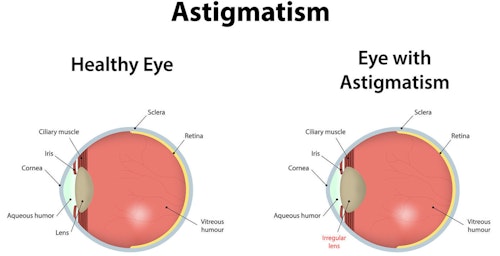According to sources, astigmatism affects between 30 and 60 percent of the adult population in certain areas. That means almost two out of three of your customers shopping for a red dot or holographic sight might be buying something they could have trouble seeing clearly.
First, you should understand what an astigmatism is (if you’re not one of the many adults who has an astigmatism yourself.) The American Optometric Association describes an astigmatism as occurring when the cornea (the clear front cover of the eye) is irregularly shaped or sometimes because of the curvature of the lens inside the eye. What that means is, as light enters the eye, rather than being focused properly on the retina at the back of the eye, the irregular shaped cornea scatters the light on the retina causing a blurred image. This blurring of the image is made worse when the focal point is a direct source of light, such as a red dot sight.
Now that you know the medical jargon, you can begin to understand and diagnose what a customer might see when they look through a red dot sight. As one of the many adults with an astigmatism, I notice it most when I’m driving at night. The headlights appear to have spears of light shooting up and down from the main light source. So rather than two spherical headlights, I see something that more closely resembles two vertical lines of light. Like a headlight, the reticle of a red dot sight is produced by a single source of light reflected back to the user off a mirror. Individuals with an astigmatism may see a reticle that appears blurry, distorted or even doubled in some cases. They may complain of a faulty sight but take special notice if you hear them say they have had this problem with other red dot sights as well.

It’s OK to ask a customer if they have an astigmatism. Like me, they may not automatically make the connection between the affliction and how it’s affecting their use of a red dot sight. One trick for diagnosing whether a distorted reticle is caused by an astigmatism or a faulty sight is to take a picture of the reticle. If the sight is to blame, the image of the reticle will appear distorted. If the user’s vision is to blame, the image of the reticle will appear clear. This can work better than you or one of your employees looking through sight and simply telling the customer, “It looks fine to me.”
Once you’ve determined the customer indeed has an astigmatism, and they still have their heart set on a red dot style sight, there are some things they can try to still have a usable sight. One thing to try is limiting the amount of light entering the eye while looking at the reticle. This can be achieved by mounting a peep sight to the rail between the red dot and the user’s eye. The settings of the sight itself may also be of some assistance. Using a lower brightness setting can also alleviate some of the distortion.
If those suggestions don’t help, a different type of sight may be in order. Before moving away from a lighted reticle sight altogether, have the customer try a holographic or prismatic sight first. Both types of sights use a slightly different method of light transmission to create the reticle, and many users with an astigmatism have said these types of sights produce less distortion. But if those don’t work, it may be time to steer the customer towards an optic with low or no magnification.
It’s possible your customer didn’t even know they had an astigmatism before they walked through your doors. Though a blurry or distorted reticle is a good indication of an astigmatism, they should be diagnosed by an optometrist. If your customer was previously unaware of their astigmatism, you might suggest they visit an optometrist to get a professional opinion. Glasses, contacts and corrective surgery can all reduce, or in some cases eliminate, the symptoms of an astigmatism.






